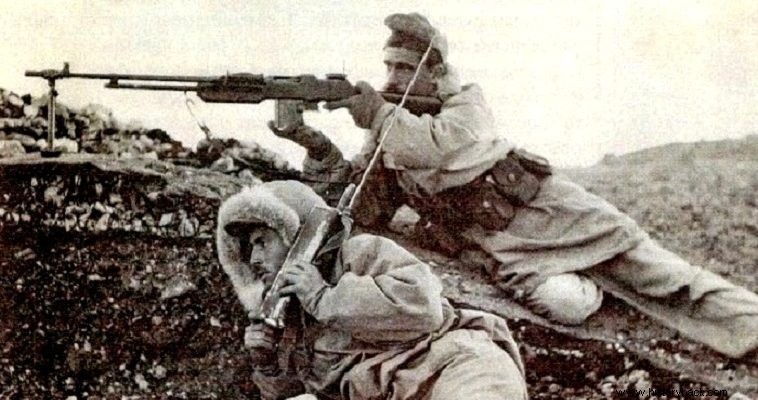
Karpenisi was the target of an attack by the KGANE (General Headquarters of Southern Greece) of the DES (Democratic Army of Greece). The attack was done for reasons of prestige, forced recruitment and looting. However, the attack against Karpenisi should not come as a bolt from the blue. The Greek Army should and could have caught up with her. But due to mistakes and omissions nothing was done and finally the city was taken over by the DSE.
The capture of Karpenisi caused serious reactions. It was a non-serious blow, even at the moment when the tide had definitively started to tilt in favor of the Hellenic Army (HE). Papagos' immediate reaction was to order a counterattack with all available forces.
Powers and plans
However, the counterattack did not take place due to the bad weather conditions. On January 29, however, Papagos assigned the operation to recover the city to the 1st SS and its commander, Lieutenant General Tsakalotos. Tsakalotos had the following forces:the Headquarters of the ASDSE (Supreme Military Command of Mainland Greece) and later the Tactical Headquarters of Agrinio with the 15th Infantry Division (MP) (45th, 71st, 73rd Infantry Brigades – TXPZ), the Western Sector Command ( DTT) with the 1st and 2nd Mountain Commando Squadrons (MOK), the 39th Light Infantry Regiment (LIP) and the 581st Infantry Battalion (TO).
The action plan provided that the liberation of the city and the destruction of the rebels would be achieved through simultaneous offensive actions, from Lamia and from Agrinio. Taking over the operation, Tsakalotos issued the following daily order:"The strikes against the gangs are now final... We will hunt them wherever they go. In the Peloponnese for 40 days our units chased them and are chasing them without rest. This pursuit has crushed them and they surrender daily... We are not going to stop day or night... The Virgin Mary is with us. Th. Tsakalotos".
From this period, the basic tactic was established:"Night and day hunting". Tsakalotos did not consider any department to have a static seat anymore. Each division had to be always able to pursue the enemy wherever he appeared
On the other side, KGANE had the headquarters company of the commander of Karagiorgis (120 fighters), the officers' school (130 fighters), the 1st division of Giotis with a command company (50 fighters) and the 138th and 192nd brigades, under Zacharias and Batekos respectively, with 640 and 590 fighters, the 2nd division of Diamantis (Yiannis Alexandrou) with the command company (50 fighters) and the 172nd and 144th brigades of Olympisios and Athanasios, respectively, with 590 and 650 fighters. In total, they had about 2,800 fighters. The rebel forces had high morale due to their recent successes. After all, they owned Karpenisi.
Counterattack
From the night of January 29-30, the movement of the divisions from Lamia and Agrinio began and through continuous laborious marches under extremely adverse weather conditions with the snow exceeding 1.5 m in some places. while units moving from Lamia (45th TXPZ) the heights of Rovies and Ag. Georgios, incoming, on February 8 in the city of Karpenisi , which had remained under the rebel yoke for 18 days, and the Agrinio divisions on the 29th to 30th occupied the heights of Frangistas and continued their movement eastward.
The rebel forces, divided into phalanxes, moved towards the North in pursuit as the ES forces from Lamia and Agrinio managed to unite. Until the 19th of February, the units of the ES tried to prevent the escape of the insurgents towards the mountainous mass of Vardousia, but they did not succeed. Tsakalotos, however, continued to pursue the commandos with a spearhead. However, due to the adverse weather conditions, it was not possible to close the trap and completely neutralize them.
The rebels, realizing the danger of their destruction, decided to flee towards Agrafa. On February 22 they attacked Lidoriki as a decoy and finally ended up in Agrafa. However, they were noticed on the morning of February 28, when their pursuit began with the 45th Airborne Division and the Commando Squadrons.
The rebels escaped temporarily, but they were the losers. They had suffered severe loss of personnel, they had lost armament and most importantly they could no longer stand anywhere. After the recapture of Karpenissi, Tsakalotos applied the tactic of quiet persecution, and in fact during the winter season and in naturally mountainous areas.
The method of silent persecution surprised the leadership of the rebel forces who were not used to aggressive actions of such an extent. In this way, Tsakalotos removed the initiative of movements from the opponent and prevented him from fulfilling his strategic missions, (eg recruiting) and caused attrition and disorganization of the rebels. Soon after all, Tsakalotos completely disbanded the KGANE, only the remnants of which managed to unite with the other DSE forces in Grammos and Vici.
